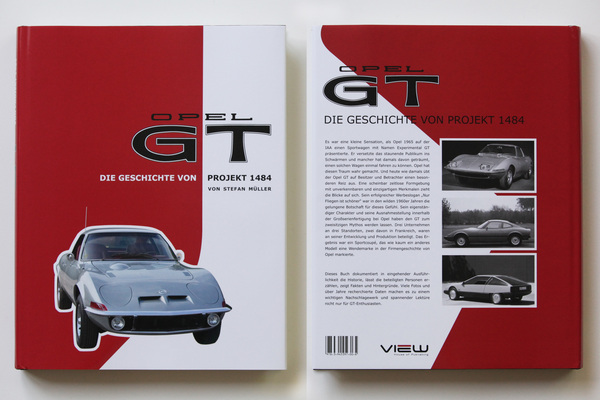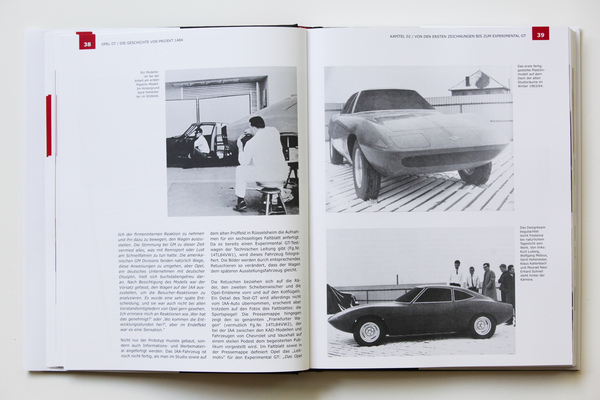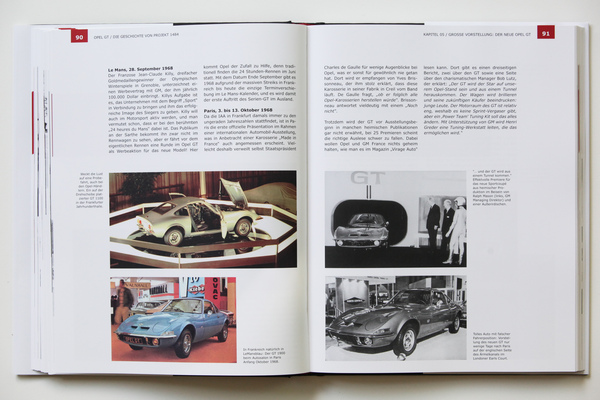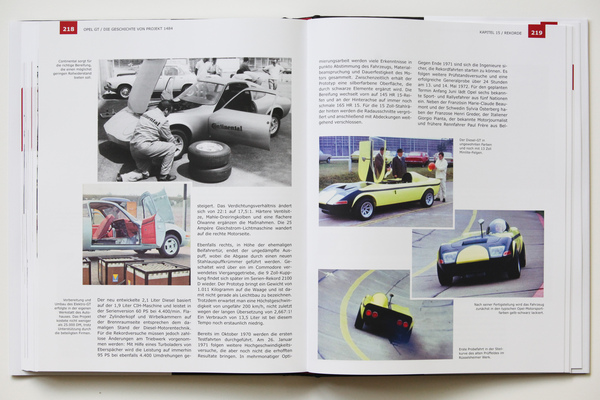The Opel GT is one of the most popular classics and, with 100,000 vehicles built, also a comparatively widespread sports car. This has also led to some literature and many articles on the captivatingly shaped coupé. So do we need yet another book? If it is as extensively researched and detailed as the present work "Opel GT - The History of Project 1484", then definitely.

Of precursors and influences
Author Stefan Müller begins his book long before the Opel GT was released and describes the men behind the idea and the cars that more or less influenced the GT. In particular, the Chevrolet Monza GT, which anticipated the shapes of the GT, is given several pages, but the Pontiac Banshee is also mentioned, even though it was unknown to the people in charge at Opel at the time.
From the first sketch to the production-ready model
Development of the Opel GT began in the fall of 1962 with Project 1484. The book traces all the design steps, shows many drawings and illustrations of clay models and tells the story up to the first drivable car, the Experimental GT from 1965. Today, it looks even more extravagant and much more valuable on the inside, but of course there was still a long way to go before it became a production model.

In 1966, a drivable model was shown to an interested public for the first time; it still had square folding headlights and would still have to undergo some fine-tuning, as the book explains step by step.

The story continues with the prototypes, which are chased over Alpine passes in 1967, until the final changes are made in July 1968. Now the GT is ready for presentation.
From presentation to marketing

A separate chapter in the book is devoted to the launch of the Opel GT, together with the marketing, which brings us back the famous advertising slogans such as "Only flying is more beautiful" and shows some of the most beautiful advertising subjects.

An extensive chapter was also devoted to production, which was carried out by a partner in France because Opel would not have been able to build the GT itself in terms of bodywork.
The various press reviews, which were meticulously collected, were also given their own chapter.
The individual model years
Stefan Müller describes each of the model years in detail and also points out the special features of the American production, which was marketed by Buick in the States.
From very special specimens
In addition to the "normal" coupé, which was available as the 1100 and 1900, an open-top variant called the "Aero GT" was also developed, but never went into series production. Müller also gives this special model plenty of space and shows it in extensive photo material.

Two very special GTs also receive a few pages. There was an electric version, with which Georg von Opel set world records, and a sustainably converted diesel version, which also achieved many best performances on the track.
About potential successors
The book also devotes an entire chapter to the end of the GT, which was not caused by customers' reluctance to buy, but by a combination of stricter US regulations - the GT would have had to be disfigured with ugly bumpers - and the termination of the coachbuilding contract by the French partner, which had been taken over by Renault.

Of course, the successor GT2, which was never built in series, is also described and shown in some pictures, as well as some Chevrolet models that could have succeeded the GT.
With a comprehensive data section
The 250-page book is supplemented by a buyer's guide and a 20-page data section, which also shows the color palettes and production figures. There really isn't much more you could want to know.
Rich in pictures
The book can definitely not be accused of a lack of pictures. Some of them would certainly have been richer in contrast, sharper or more colorful, but this work is not intended to be a picture book, but an illustrated story. And so the pictures are less central than they might be in a coffee-table book. That's a good thing, we think. It's the text and the wealth of information that make the difference and here the book completely fulfills expectations.
At 39.90 euros, the book ""Opel GT - The History of Project 1484" is no bargain, but it is solidly researched, sufficiently well printed and, above all, it leaves out hardly any detail of the history of the Opel GT. This makes it a must for GT fans, of course, but also a purchase worth considering for car fans in general.
Bibliographical details
- Title: Opel GT - The history of project 1484
- Author: Stefan Müller
- Publisher: View, 1st edition (July 10, 2014)
- Language: German
- Dimensions: 254 pages, 27.6 x 22 x 2.4 cm, richly and partially illustrated in color/black and white
- ISBN-10: 3945397006
- ISBN-13: 978-3945397008
- Price: Euro 39.90
- To order: At amazon.de
























